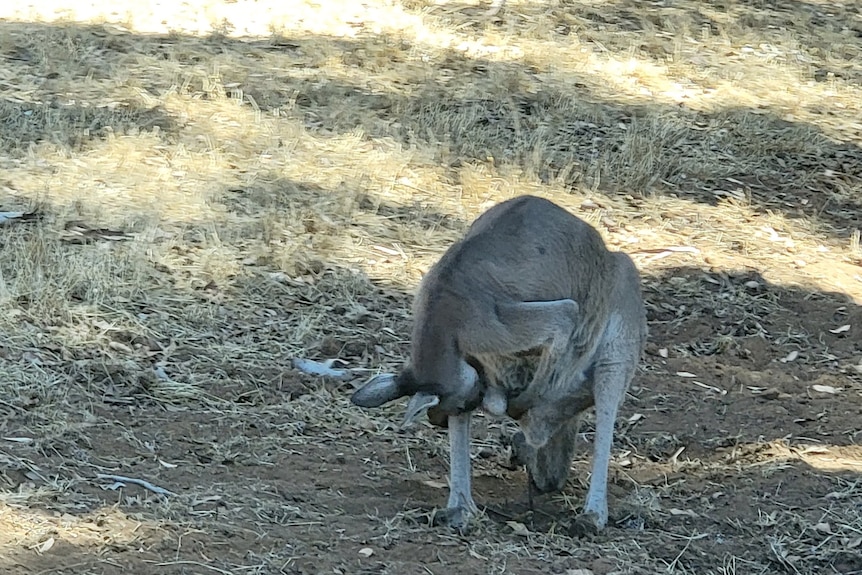As Western Australia prepares to sizzle through another heatwave, kangaroos have been spotted using a rather unusual tactic to cool down.
Going for a dip in a freshwater lake or seeking shade from the branches of a eucalyptus tree sound like obvious ways for animals to lose heat during warmer months.
However, wildlife carer Michelle Jones said she noticed kangaroos on her Geraldton property doing something a little different.
“When it gets really, really hot like we’ve been having these days, the [male kangaroos] actually use those little paws and arms,” she said.
“And they will grab their testicles … and they’ll actually furiously lick them all over, soaking them in a saliva which pretty much coats them and helps them cool down as well.”
Ms Jones said the joeys tended to just lick their arms, as they only had “tiny fluffy balls”, but the adults took it a step further.
“It obviously works for them,” she said.
“And then they lay back on their tail, and some of them will actually lay quite exposed, letting the nice, cold air hit them in that region as well.”

Curtin University wildlife ecologist Bill Bateman said the tactic was simple yet effective.
“It’s thin skin and the blood vessels are close to the surface, so that hot blood is pumping away really close to where the sun is falling on them,” Dr Bateman said.
“So, if the kangaroo licks his arms or his balls, then that will help with evaporative cooling … it’s precisely the same reason why we’ll get a wet flannel or a wet towel and sort of mop ourselves down.”
Loading…
Heatwaves pose risks
The Bureau of Meteorology’s Jessica Lingard said Western Australia had experienced hotter and drier conditions this summer, with several heat records broken across the state.
Ms Lingard said the Mid West town of Geraldton usually had one day over 44 degrees Celsius every five years, but it had already sweltered past that temperature five times in February.
Late last month, Bridgetown, three hours south of Perth, sizzled to its hottest day in 25 years, with a top of 42.6C.

“We’ve had relentless heat, we’ve got these constant troughs down the west coast driving those easterly and north-easterly winds … and really seeing record-breaking temperatures across [southern and northern] WA,” Ms Lingard said.
“We’re seeing all of these climate drivers on top of the background warming that is climate change.
“It’s making it easier and more common to see these extreme temperatures during the warmer months.”
Low heatwave and severe conditions are expected to continue for most of the state this week.
Dr Bateman said native animals could cope with the odd hot day, but prolonged extreme temperatures could be “a real problem”, particularly for mammals.

He said reptiles were better accustomed to heat, as they would dig down into leaf litter or under logs and stop eating to keep their body temperatures down.
“But none of those options are really there for mammals and birds over long periods of time,” Dr Bateman said.
“They can slow down for a day, they can eat less for a day, they can hide away in shade for a day, but when the temperatures persist for a long time, then they really start suffering.”
Dr Bateman said he was concerned more native species would die as heatwaves become more common.
“Eventually, none of the behavioural or physiological tactics that animals have will protect them any longer and they’ll start dying … it is a severe problem,” he said.
“When we have extremes that go on for long periods of time, which we know we’re having because of climate change, then it really starts having an impact on their populations rather than on individuals.”

What can you do to help?
Dr Bateman said it could be confronting to learn about the effects of heat waves, but there were small, simple steps people could take in their own backyard to help protect wildlife.
“It doesn’t matter if you’ve got a big, vegetated garden or whether you’ve got a little apartment … we can make sure that our gardens have shelter … we can provide water through shallow bowls, bird baths or sprays,” he said.
“If we can provide water for them in these extreme, hot times, we can make a bit of a difference.”
